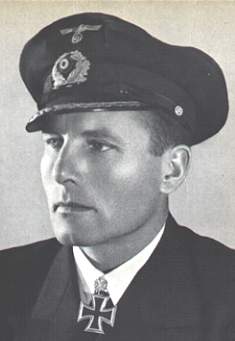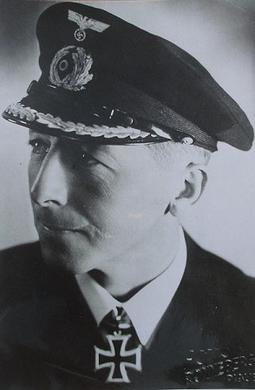
Karl Dönitz was a German admiral who briefly succeeded Adolf Hitler as head of state in May 1945, holding the position until the dissolution of the Flensburg Government following Germany's unconditional surrender to the Allies days later. As Supreme Commander of the Navy beginning in 1943, he played a major role in the naval history of World War II.

The Kriegsmarine was the navy of Nazi Germany from 1935 to 1945. It superseded the Imperial German Navy of the German Empire (1871–1918) and the inter-war Reichsmarine (1919–1935) of the Weimar Republic. The Kriegsmarine was one of three official branches, along with the Heer and the Luftwaffe, of the Wehrmacht, the German armed forces from 1935 to 1945.

The Reichsmarine was the name of the German Navy during the Weimar Republic and first two years of Nazi Germany. It was the naval branch of the Reichswehr, existing from 1919 to 1935. In 1935, it became known as the Kriegsmarine, a branch of the Wehrmacht; a change implemented by Adolf Hitler. Many of the administrative and organizational tenets of the Reichsmarine were then carried over into the organization of the Kriegsmarine.

Günther Prien was a German U-boat commander during World War II. He was the first U-boat commander to receive the Knight's Cross of the Iron Cross and the first member of the Kriegsmarine to receive the Knight's Cross of the Iron Cross with Oak Leaves of Nazi Germany. It was Germany's highest military decoration at the time of its presentation to Prien.

Herbert Emil Schultze, was a German submarine commander during World War II. He commanded the U-48 for eight patrols during the early part of the war, sinking 169,709 gross register tons (GRT) of shipping. Schultze was a recipient of the Knight's Cross of the Iron Cross with Oak Leaves of Nazi Germany.

Wolfgang Lüth was a German U-boat captain of World War II who was credited with the sinking of 46 merchant ships plus the French submarine Doris sunk during 15 war patrols, for a total tonnage of 225,204 gross register tons (GRT).

Karl-Friedrich Merten commanded the U-boat U-68 in Nazi Germany's Kriegsmarine during World War II. He received the Knight's Cross of the Iron Cross with Oak Leaves. Merten was credited with the sinking of 27 ships for a total of 170,151 gross register tons (GRT) of Allied shipping. Merten joined the Reichsmarine in 1926. He served on the light cruisers Karlsruhe and Leipzig during the Spanish Civil War patrols.
The Befehlshaber der Unterseeboote or BdU was the supreme commander of the German Navy's U-boat Arm (Ubootwaffe) during the First and Second World Wars. The term also referred to the Command HQ of the U-boat arm.

Werner Hartenstein was a German naval officer during World War II who commanded the U-boat U-156. He was a recipient of the Knight's Cross of the Iron Cross, the highest award in the military and paramilitary forces of Nazi Germany during World War II. Hartenstein was credited with sinking 19 ships totaling 97,504 gross register tons (GRT), and with damaging three ships and a destroyer.

Hans-Jürgen "Hansjürgen" Rudolf Reinicke was a Kapitän zur See, commander of heavy cruiser Prinz Eugen, in Nazi Germany's Kriegsmarine during the Second World War and recipient of the Knight's Cross of the Iron Cross.
Ernst Hechler was a German bomber pilot and U-boat commander in World War II. He was a recipient of the Knight's Cross of the Iron Cross of Nazi Germany. Hechler is credited with the sinking of four ships for a total of 13,804 gross register tons (GRT), and with damaging one destroyer escort.

BETASOM was a submarine base established at Bordeaux, France by the Regia Marina Italiana during World War II. From this base, Italian submarines participated in the Battle of the Atlantic from 1940 to 1943 as part of the Axis anti-shipping campaign against the Allies.

Hubert Schmundt was a German admiral during World War II. He was a recipient of the Knight's Cross of the Iron Cross of Nazi Germany.
The post of Führer der Unterseeboote (FdU) was the senior commanding officer of U-boat forces in a theatre of war. The submarine service in the Kaiserliche Marine of World War I and the Kriegsmarine of World War II, used the title for several senior commands during those conflicts. It was senior to Flotilla chief (Chef) and was introduced as U-boat forces in an area expanded beyond flotilla size. In 1917 the posts of FdU were themselves subordinated to an overall "Commander of the U-boats". The post of FdU was revived in the 1930s with German re-armament and was held from January 1936 and until 17 October 1939 by Karl Dönitz. On that date he was named BdU, and two subordinate FdU posts were established, FdU West and FdU Ost . In the further course of the war, several further posts were created for the commanders of U-boat regions

Johann Günther Lütjens was a German admiral whose military service spanned more than 30 years and two world wars. Lütjens is best known for his actions during World War II and his command of the battleship Bismarck during her foray into the Atlantic Ocean in 1941.

The organization of the Kriegsmarine refers to the operational and administrative structure of the German Navy from 1935 to 1945. Many of the organizational tenets of the Kriegsmarine were inherited from its predecessor the Reichsmarine. As World War II unfolded, the Kriegsmarine expanded to cover additional regions and responsibilities, most significant of which was the occupation of France and the Battle of the Atlantic.
Naval regions and districts were the official shore establishment of Nazi Germany's Kriegsmarine during World War II. The Kriegsmarine shore establishment was divided into four senior regional commands, who were in turn subordinated to the operational Navy Group commanders who commanded all sea and shore naval forces within a particular geographical region. Within each naval region were several subordinate naval districts who were responsible for all navy shore activities within their area of responsibility, most significantly were the various German ports of occupied Europe.
The Commander of Ships of the Line was a naval command of the Reichsmarine, as well as briefly the Kriegsmarine, from 1930 through 1936. The commander of liners was an administrative posting assigned to oversee the development and deployment of German capital ships, but did not operationally control the ships once at sea.

Surface flotillas of the Kriegsmarine were organizational groupings of German naval vessels during World War II based on class of vessel and geographical location. Surface flotillas were not operationally deployed units, but functioned through the administrative command chain of the Kriegsmarine.
















